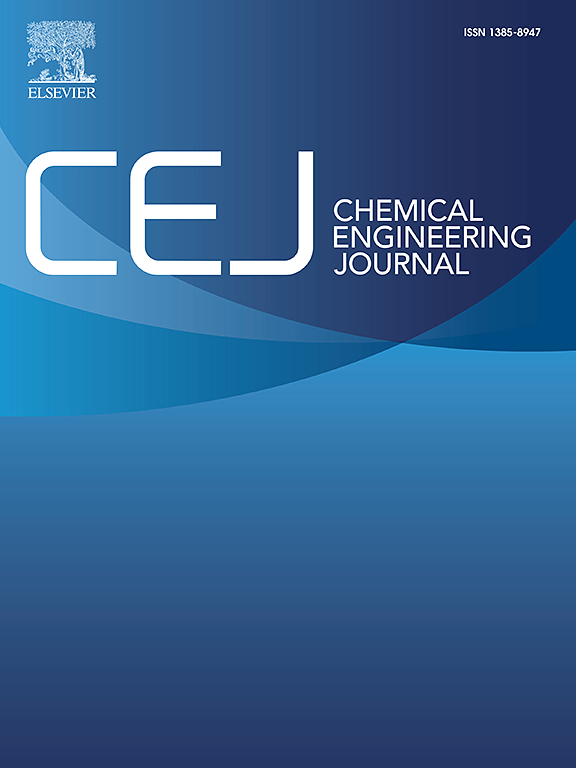Preparation of CeO2/biochar composites by flash Joule heating and the research on its efficient removal performance of VOCs
IF 13.2
1区 工程技术
Q1 ENGINEERING, CHEMICAL
引用次数: 0
Abstract
Volatile organic compounds (VOCs) are hazardous air pollutants that pose significant risks to human health and the environment. In this study, CeO2-loaded biochar composites (CeO2@BC-J) were rapidly synthesized via flash Joule heating (FJH), using wheat straw as the carbon source. The resulting composites exhibited a high specific surface area (160.04 m2·g−1), uniform CeO2 dispersion, and enhanced porosity. Fixed-bed adsorption tests showed that CeO2@BC-J achieved a toluene adsorption capacity of 301.24 mg·g−1, far surpassing its conventionally prepared counterpart (CeO2@BC-G). Kinetic and isotherm analyses revealed a dual adsorption mechanism involving both physisorption and chemisorption. In situ DRIDTS spectra showed the emergence of C O and C
O and C O bonds during toluene adsorption, confirming surface oxidation reactions. Density functional theory (DFT) calculations and charge density difference analysis further demonstrated electron transfer from toluene to CeO2, accompanied by Ce4+ reduction to Ce3+ at oxygen vacancy sites. This study not only demonstrates the effectiveness of FJH in constructing high-performance VOCs adsorbents, but also provides mechanistic insights into redox-enhanced adsorption pathways.
O bonds during toluene adsorption, confirming surface oxidation reactions. Density functional theory (DFT) calculations and charge density difference analysis further demonstrated electron transfer from toluene to CeO2, accompanied by Ce4+ reduction to Ce3+ at oxygen vacancy sites. This study not only demonstrates the effectiveness of FJH in constructing high-performance VOCs adsorbents, but also provides mechanistic insights into redox-enhanced adsorption pathways.

闪蒸焦耳加热法制备CeO2/生物炭复合材料及其对VOCs的高效去除性能研究
挥发性有机化合物(VOCs)是对人类健康和环境构成重大风险的有害空气污染物。本研究以麦秆为碳源,通过闪速焦耳加热(FJH)快速合成了负载ceo2的生物炭复合材料(CeO2@BC-J)。复合材料具有较高的比表面积(160.04 m2·g−1),CeO2分散均匀,孔隙率提高等特点。固定床吸附实验表明,CeO2@BC-J对甲苯的吸附量为301.24 mg·g−1,远远超过常规制备的对甲苯吸附量CeO2@BC-G。动力学和等温线分析揭示了一种双重吸附机制,包括物理吸附和化学吸附。原位DRIDTS光谱显示,在甲苯吸附过程中出现了CO和CO键,证实了表面氧化反应。密度泛函理论(DFT)计算和电荷密度差分析进一步证明了电子从甲苯转移到CeO2,同时在氧空位位置Ce4+还原为Ce3+。该研究不仅证明了FJH在构建高性能VOCs吸附剂方面的有效性,而且为氧化还原增强吸附途径提供了机理见解。
本文章由计算机程序翻译,如有差异,请以英文原文为准。
求助全文
约1分钟内获得全文
求助全文
来源期刊

Chemical Engineering Journal
工程技术-工程:化工
CiteScore
21.70
自引率
9.30%
发文量
6781
审稿时长
2.4 months
期刊介绍:
The Chemical Engineering Journal is an international research journal that invites contributions of original and novel fundamental research. It aims to provide an international platform for presenting original fundamental research, interpretative reviews, and discussions on new developments in chemical engineering. The journal welcomes papers that describe novel theory and its practical application, as well as those that demonstrate the transfer of techniques from other disciplines. It also welcomes reports on carefully conducted experimental work that is soundly interpreted. The main focus of the journal is on original and rigorous research results that have broad significance. The Catalysis section within the Chemical Engineering Journal focuses specifically on Experimental and Theoretical studies in the fields of heterogeneous catalysis, molecular catalysis, and biocatalysis. These studies have industrial impact on various sectors such as chemicals, energy, materials, foods, healthcare, and environmental protection.
 求助内容:
求助内容: 应助结果提醒方式:
应助结果提醒方式:


